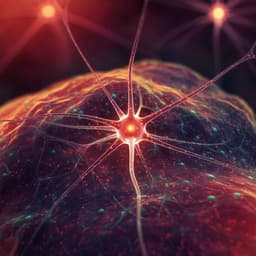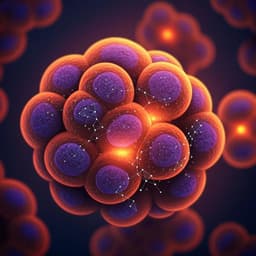
Medicine and Health
Single-cell transcriptomics of human iPSC differentiation dynamics reveal a core molecular network of Parkinson's disease
G. Novak, D. Kyriakis, et al.
Explore the groundbreaking findings from a study by Gabriela Novak and colleagues, which reveals a converging network for Parkinson's disease pathways using midbrain dopaminergic neurons derived from human induced pluripotent stem cells. This research uncovers significant alterations in gene expression and dopamine metabolism, potentially enhancing our understanding of the disease's phenotypic heterogeneity.
~3 min • Beginner • English
Introduction
The study addresses why midbrain dopaminergic neurons degenerate in Parkinson's disease and seeks molecular mechanisms underlying PD, focusing on the PINK1 ILE368ASN mutation linked to early-onset PD. Background highlights PD prevalence and lack of disease-modifying therapies, the central role of mitochondrial dysfunction and mitophagy in genetic PD, and broader PINK1 functions beyond mitophagy. Due to limited human postmortem tissue and species differences limiting animal models, the authors employ human iPSC-derived midbrain dopaminergic neurons, which follow a distinct developmental trajectory and exhibit PD-relevant vulnerability. The goal is to use single-cell transcriptomics across differentiation to identify consistent dysregulation caused by PINK1-ILE368ASN and integrate these into a network to reveal convergent PD pathways, corroborated by proteomics.
Literature Review
The paper reviews PD genetics, noting that monogenic mutations explain a minority of cases but illuminate key pathways such as mitochondrial homeostasis, repair, and mitophagy (PINK1/PARKIN axis). It summarizes broader PINK1 roles in neuronal maturation, neurite outgrowth, mitophagy regulation, and cell cycle control, indicating potential widespread impact of loss-of-function mutations. The authors discuss unique developmental origin and identity of midbrain dopaminergic neurons versus other dopaminergic populations, driven by SHH and Wnt signaling and absence of PAX6, and the implications for selective vulnerability and species differences that complicate animal modeling. Prior studies establishing iPSC reprogramming and directed differentiation protocols to generate authentic mDA neurons are cited, as are recent single-cell atlases of human and mouse mDA development used to benchmark in vitro differentiation.
Methodology
- Cell lines and reprogramming: Fibroblasts from a male PD patient (Coriell ND40066) homozygous for PINK1 ILE368ASN (p.I368N) were reprogrammed to iPSCs (Sendai virus). Karyotypes (aCGH) were normal; mutation was PCR-verified and sequenced (NCBI OK050183.1). A sex- and age-matched healthy control iPSC line (17608/6; ref. 38) was used.
- iPSC validation: Immunocytochemistry for POU5F1/OCT4 and TRA-1-60; TaqMan hPSC Scorecard for self-renewal and trilineage potential; single-cell detection of stemness markers and proposal of a robust stemness panel (MYC, POU5F1, LIN28A, TDGF1, L1TD1, USP44, POLR3G, TERF1).
- Differentiation to mDA neurons: Parallel differentiations of PINK1 and control lines using an optimized floor-plate protocol with staged SHH and Wnt signaling. Four independent pairs were initiated at staggered times to capture different differentiation stages on a common collection day. Cells were sampled at multiple days (iPSCs, D6, D10, D15, D21, D26, D35, D50) for characterization; D10 had low viability in PINK1 and was excluded from pairwise DEG analyses.
- Phenotypic validation: ICC for mDA markers (TH, PITX3, LMX1A, DAT) and neuronal marker MAP2 at D25 and D35; qPCR for TH, LMX1A, ALDH1A1 across time. scRNAseq expression benchmarking to human mDA developmental gene programs to confirm in vitro recapitulation.
- Single-cell RNA-seq (Drop-seq): Custom microfluidic device fabrication and droplet generation; barcoded bead capture; library prep (Nextera XT) and Illumina NextSeq 500 PE (R1: 20 bp cell barcode/UMI; R2: 50 bp gene). QC and processing with Drop-seq pipeline to a digital gene expression matrix.
- scRNAseq data processing: Strict cell and gene QC filters (MAD-based thresholds; mitochondrial content), Seurat integration with SCTransform; 4495 high-quality cells (2518 control; 1977 PINK1) and 39,194 genes (18,097 used downstream). PCA, Louvain clustering, UMAP, and curated markers to annotate differentiation stages.
- Differential expression: MAST with total transcript counts as covariate; Bonferroni correction. Pairwise comparisons at each timepoint (iPSC, D6, D15, D21) required consistent direction and significance across timepoints; alternative aggregations defined DEG Groups A–D by including/excluding iPSCs and averaging fold changes to mitigate stage variability. Final union yielded 292 DEGs.
- Network analyses: Protein–protein interactions assembled from STRING v11 and GeneMANIA, retaining only strong physical/genetic/pathway interactions; removed predicted/text-mined and any database-added nodes to yield a DEG-only core PPI (246 protein-coding DEGs; 2122 interactions). Assessed topology (betweenness centrality in Gephi), compared to 50 random gene sets (significant differences; Wilcoxon p=2.22e-16). Built a DEG correlation network (p<0.05, r>0.1) and intersected with PPI to obtain a 297-edge consensus. Enrichment analyses (STRING) identified KEGG/Reactome/GO processes.
- Integration with PARK genes: Mapped interactions between the DEG network and all 19 protein-coding PARK genes, retaining only PARK–DEG edges to assess convergence.
- Proteomics: Label-free quantitative LC–MS/MS at D25 and D40 (two biological replicates each). Sample prep with SDC lysis, trypsin/Lys-C digestion; Thermo Q Exactive-HF DDA acquisition. MaxQuant v1.6.17.0 (FDR<1%, MaxLFQ, match-between-runs). Differential protein abundance (FDR<0.05; |log2FC|>1), network analysis, and overlap with scRNAseq DEGs.
Key Findings
- iPSC differentiation and identity:
- In vitro differentiation recapitulated human mDA development, with SHH (PTCH1) and Wnt (FZD7) receptor expression peaking at D6, and mDA lineage factors (e.g., TCF12, ALCAM, ASCL1, DDC) enriched by D21. ICC confirmed TH/PITX3/LMX1A/DAT expression by D25–D35. DA-like cells increased to ~61% by D35.
- A robust scRNA-detectable stemness gene panel was proposed: MYC, POU5F1, LIN28A, TDGF1, L1TD1, USP44, POLR3G, TERF1.
- DEG discovery and characteristics:
- After QC (4495 cells; 18,097 genes), consistent cross-timepoint analyses identified 292 DEGs (union of Groups A–D), with 246 protein-coding genes forming a connected PPI network (2122 interactions).
- Pairwise strict criterion across iPSC, D6, D15, D21 yielded 27 core DEGs (14 up, 13 down). Excluding iPSCs expanded to 55 additional DEGs (total 56 in Group A). Aggregated criteria produced 151 (Group B), 172 (Group C), and 286 (Group D) DEGs; union 292.
- Enrichment: Top KEGG pathway was Parkinson's disease; others included spliceosome, Huntington's disease, thermogenesis. Reactome highlighted respiratory chain transport; GO terms included ubiquitination-related bindings, Ran GTPase binding, and chaperones.
- Network integration and convergence:
- The DEG PPI network is non-random (more proteins/interactions than 50 random sets; distinct degree distribution). Central nodes (high betweenness) include HSPA8, EEF1A1, PSMA4, CYCS, ACTN1, PGK1, PHB, SHH, BRCA2, VPS39, UQCRFS1, CNTNAP2, CUL3, PLCB4, EGLN3; many are previously implicated in PD or α-synuclein biology, proteostasis, and mitochondrial function.
- All 19 protein-coding PARK genes directly connect to at least one DEG, often via central nodes, demonstrating convergence of diverse PD genes on the core network. CHCHD2 (PARK22) was itself a DEG and connected to SLC25A4/ANT1, GHITM, and NME4.
- Functional themes across the network: ubiquitination/proteasome, mitochondrial pathways, lysosomal processes, cellular stress/catabolism, RNA processing/translation, aromatic compound metabolism/purine pathway, vesicle-mediated transport/exocytosis, and protein localization/folding.
- Proteomics phenotype:
- 39 proteins were differentially abundant (|log2FC|>1, FDR<0.05) across D25 and D40; 31 at D25, 12 at D40, with 4 overlapping both stages (TH, DDC, NES, VIM). Several proteins overlapped with scRNAseq DEGs (e.g., CSRP2, VWA5A), and the proteomic network overlapped the transcriptomic core, indicating consistent pathway perturbations.
- Altered abundance of TH and DDC at both timepoints points to impaired dopamine metabolism in PINK1-ILE368ASN neurons.
- Additional observations:
- PINK1-mutant cells at D10 showed low viability (timepoint excluded). 68% of protein-coding DEGs are already associated with PD by literature/GWAS/experimental links.
Discussion
The findings indicate that a PINK1 ILE368ASN mutation induces a persistent, early dysregulation of a tightly connected core molecular network that encompasses key PD pathways such as ubiquitination, mitochondrial function, RNA/protein metabolism, and vesicular transport. The direct integration of all 19 PARK proteins into this network suggests that disparate genetic causes of PD converge mechanistically on common network nodes and pathways, providing a unifying model for PD pathogenesis and potentially explaining phenotypic heterogeneity and shared outcomes. Central nodes like HSPA8, PSMA4, CUL3, and PGK1 serve as hubs linking multiple processes, implying that their perturbation could mediate downstream pathology, including α-synuclein handling and mitochondrial quality control. Proteomic alterations, including consistent changes in TH and DDC, corroborate transcriptomic predictions by demonstrating functional impairment of dopaminergic metabolism in maturing neurons. Early and consistent network dysregulation before overt degeneration aligns with the notion that PD pathology precedes clinical symptoms and points to early biomarkers and intervention targets. The study also expands the view of PINK1’s influence beyond direct PINK1–PARKIN mitophagy, implicating upstream modifiers and alternative routes within the PARKIN pathway.
Conclusion
This work maps a core PD-related molecular network by integrating single-cell transcriptomics across human iPSC-to-mDA differentiation with network biology and proteomics in a PINK1 ILE368ASN model. It demonstrates that numerous PD-relevant pathways are consistently dysregulated early and that all protein-coding PARK genes connect to this core network, supporting a convergent, network-centric model of PD pathogenesis. Proteomic validation substantiates functional deficits in dopamine metabolism. These insights suggest common, potentially druggable nodes and pathways that might transcend individual genetic etiologies and inform early diagnostics and therapeutic strategies. Future research should extend analyses to mature and aging neurons, incorporate isogenic controls and multiple genetic backgrounds, and test whether idiopathic PD exhibits similar network dysregulation to refine targets for disease modification.
Limitations
- Temporal scope focused on early differentiation (to D21 for scRNAseq), limiting conclusions about mechanisms in mature/aging neurons where degeneration manifests.
- Single mutant and control lines were used; although the strong, fully penetrant PINK1 mutation mitigates background effects, broader validation across donors and isogenic pairs is needed.
- The D10 timepoint exhibited low viability in PINK1 cells and was excluded from pairwise analyses, potentially reducing temporal resolution.
- scRNAseq sensitivity constraints limit detection of lowly expressed genes (e.g., EN1 required qPCR confirmation).
- Network inference relies on existing PPI databases with incomplete or context-agnostic interactions; functional causality was not directly tested in this study.
- In vitro differentiation may not fully recapitulate in vivo aging and environmental factors relevant to idiopathic PD.
Related Publications
Explore these studies to deepen your understanding of the subject.







